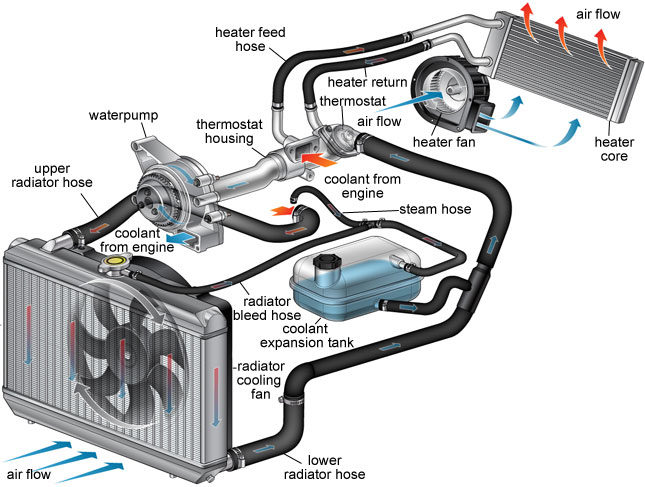How does a Radiator Work?
A Radiator has a number of flat and thin pipes arranged horizontally one below the other. Water flows through these pipes along their length. But how does the water flowing through these pipes gets cool so fast? So to increase the heat exchange from water to air, we have fins brazed between the flat surfaces of these pipes. These fins between the pipes look like a dense sine wave (trigonometric function). Thus increasing the surface area that comes in contact with air and increasing the heat exchange.

Is it all we have in a radiator to exchange heat? Then no, we are not done yet.
High end car radiators are a bit more sophisticated, we have fins like structures inside the radiator pipes. These are added to create turbulence in the water flowing through them. The water flowing through pipes without internal fins is streamline. Thus the heat exchange will be between the outer layer of water and the air. As the outer layer of water gets cooler, It reducing the temperature difference between air and water as a result, the rate of heat exchange will decrease.
Whereas in the radiator pipes with internal fins, water molecules that exchange heat with air get mixed up with hot water, due to turbulence created by these fins. Thus keeping the temperature of the whole water uniform and high. In this way, a greater amount of heat could be exchanged and coolant gets cooler at a really very fast pace.
Also Read:
- Different Types of Engine
- How a Car Air Conditioning System Works? – Nicely Explained
- How Suspension System Works in Automobile?
What is the function of a pressure cap in a Radiator?
Temperature of engine goes way much higher than 100 degree centigrade, and water is used as a coolant in cars. But the water starts boiling at 100 degrees and gets converted into steam. And steam does not exchange heat at a good pace. So how water can be used as a coolant.
To solve this problem pressure caps are introduced in a radiator. Pressure cap does not allow the pressure formed in the radiator to escape created by hot water coming from the engine . Thus there is an increase in pressure inside radiator as water get’s hotter. And as we know that the boiling point of a liquid increases if it is heated at a higher pressure. So pressure cap increases the boiling point of water and keeps it in liquid state even at temperatures higher than 100 degree centigrade.
Imagine if pressure in the radiator goes on increasing it could bust the radiator pipes, to short out this problem, pressure cap is equipped with a spring at its bottom, which gets lifted up as the pressure reaches around 15psi, so pressure cap acts as a valve and releases the pressure to overflow tank when it exceeds the limit of 15 psi.
Transmission Oil Cooling
Ever heard of transmission oil used in gearbox and power-steering going into the radiator. In high payload vehicles, we have to cool down the transmission oil and we use our radiator to remove the heat from this oil. The side of the inlet port of the radiator is called hot side as hot water from the engine enters from this side, as water moves through pipes and gets cool and gets out of the radiator through outlet port called cold side. So we have a cylindrical structure on the cool side of the radiator through which transmission oil circulates thus exchanges its heat with cold water.
You must also know?
We add anti-freezing additives to the water to prevent it from freezing in winters, especially in Europe, and to prevent the engine from corrosion.
For better explanation about how radiator works in automobile watch the video given below:
